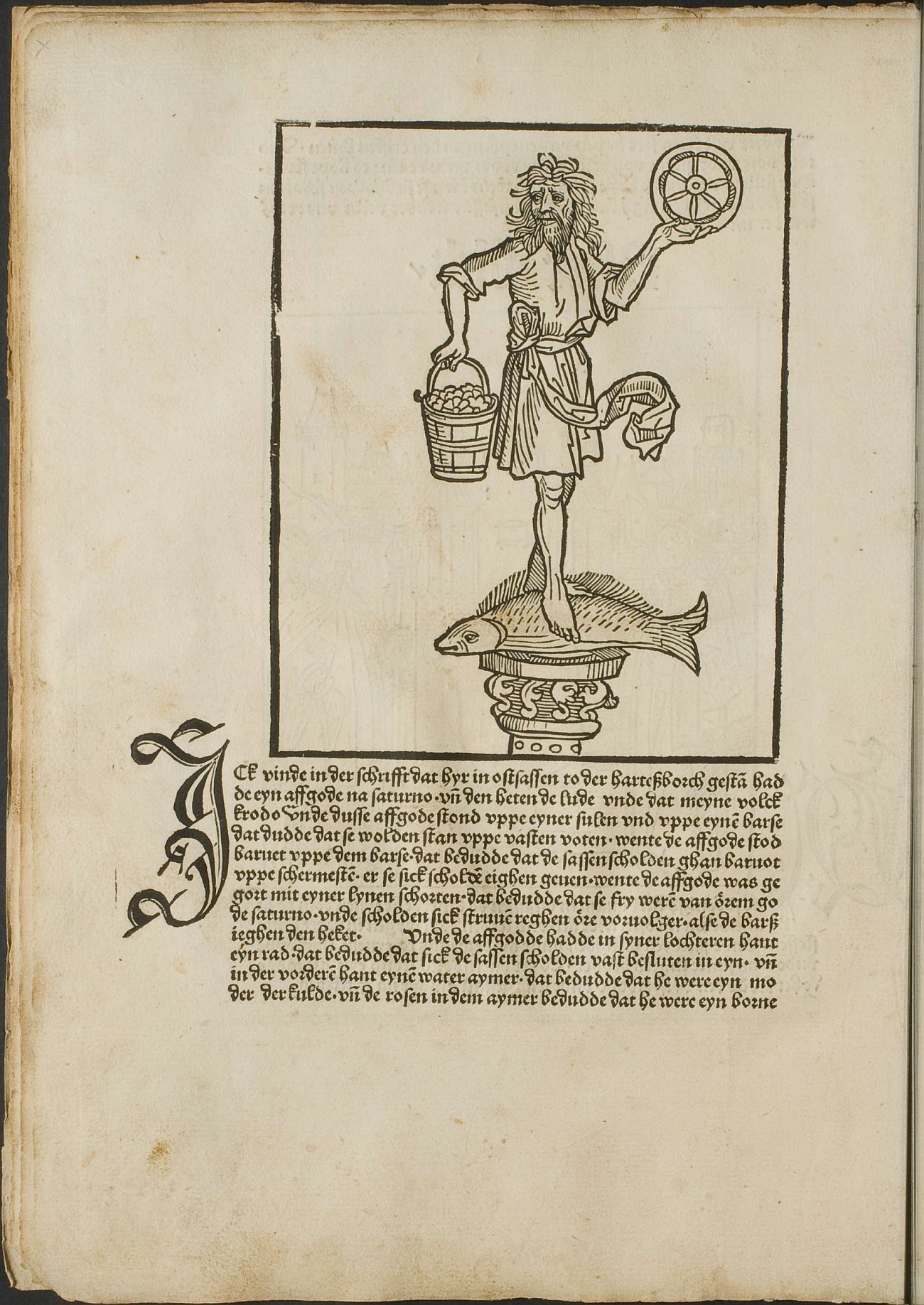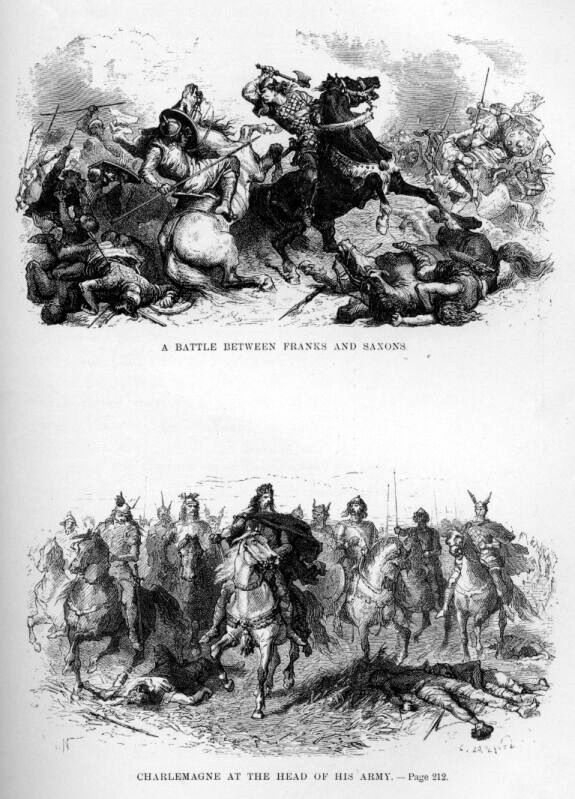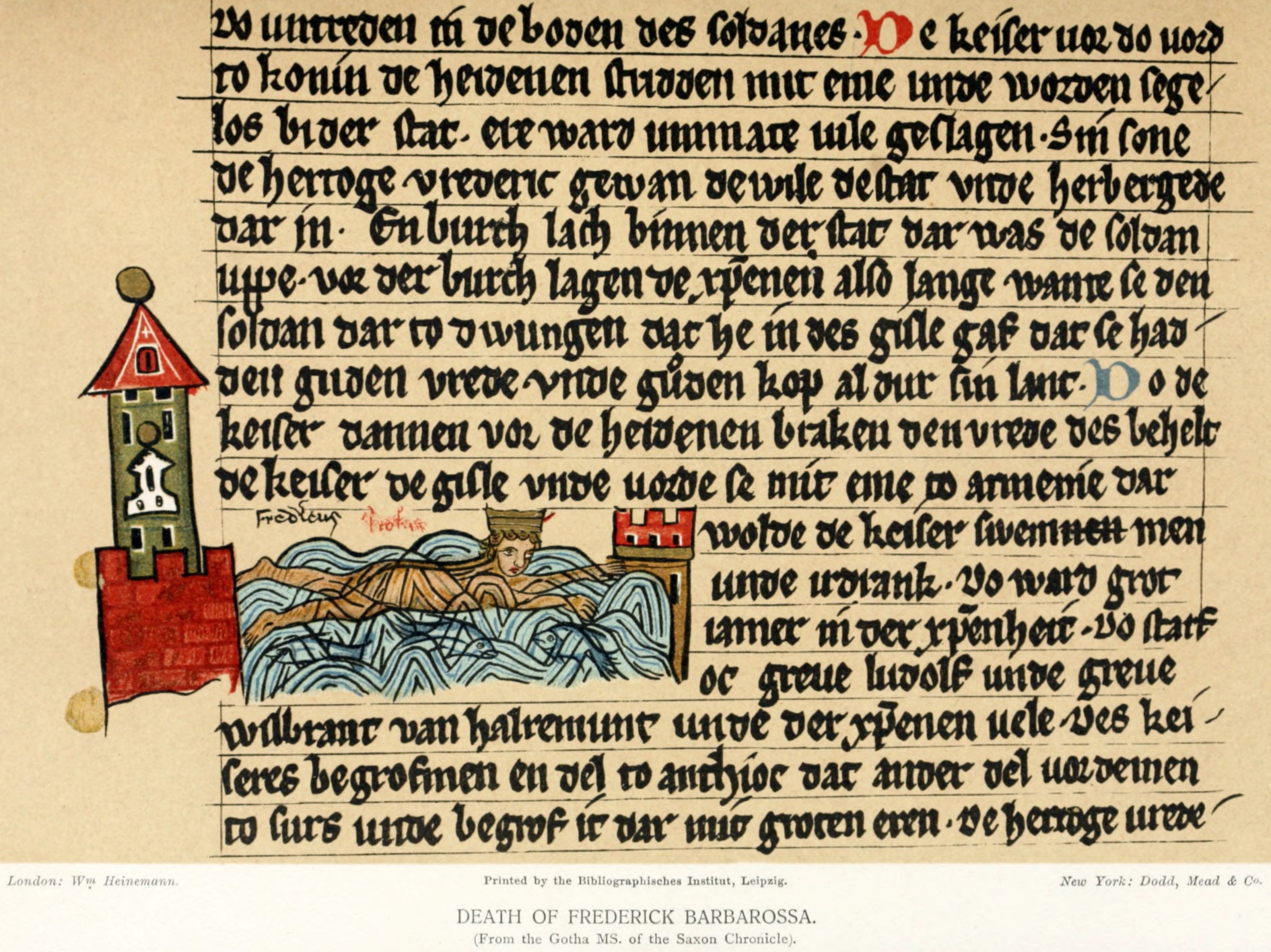|
Krodo
Krodo according to the 1492 ''Saxon Chronicle'' incunable, probably written by the Brunswick goldsmith Conrad Bothe (c. 1475 – c. 1501) and printed in the studio of Peter Schöffer at Mainz, was a Germanic god of the Saxons. He is supposed to have been similar to the Roman god Saturn. Modern historians characterize the figure of Krodo as a fake (Janzen 2017). Description The ''Saxon Chronicle'' (written in Middle Low German: ''Cronecken der Sassen'') contains a fanciful illustration of Krodo as a man clad in a linen garment with a wafting belt, who is standing on a large fish (a bass or perch) holding a bucket of roses in his right hand and an upright wheel in his left. The symbols possibly refer to the ancient four elements, though numerous further attempts at an interpretation have been given. According to Bothe, Julius Caesar during the conquests of ''Magna Germania'' ordered the erection of several fortresses crowned by statues of Roman deities; one of them was de ... [...More Info...] [...Related Items...] OR: [Wikipedia] [Google] [Baidu] |
Krodo Altar
The Krodo Altar (german: Krodoaltar) in Goslar, Germany, is an altar made entirely of bronze and is the only surviving metal church altar from the Romanesque period. It was probably made in the late 11th century. About 1600 it was popularly named after a deity Krodo which is known only from the description and drawing by ''Cord Bote'' in his ''Sassenchronik'' ("History of the Saxons", 1492). It was originally in the Collegiate Church of St. Simon and St. Jude (''Goslar Cathedral''; built 1047), which was part of the Imperial Palace of Goslar. The altar had been removed by the time the church was demolished (1819–1822) and is now on exhibition in Goslar's Town Museum (''Stadtmuseum''). Sources * Reinhard Roseneck: ''Der Rammelsberg''. Verlag Goslarsche Zeitung, Goslar 2001, * Ursula Müller, Hans-Günther Griep, Volker Schadach: ''Kaiserstadt Goslar''. Verlag Volker Schadach, Goslar 2000, * Christopf Gutmann, Volker Schadach: ''Kaiserpfalz Goslar''. Verlag Volker Schadach, G ... [...More Info...] [...Related Items...] OR: [Wikipedia] [Google] [Baidu] |
Harzburg
The Harzburg, also called Große Harzburg ("Great Harz Castle"), is a former imperial castle, situated on the northwestern edge of the Harz mountain range overlooking the spa resort of Bad Harzburg in Goslar District in the state of Lower Saxony, Germany. It was erected from 1065 to 1068 at the behest of King Henry IV of Germany, slighted during the Saxon Rebellion in 1073-75, and a century later rebuilt under Emperor Frederick Barbarossa and his Welf successor Otto IV, who died here in 1218. Later used as a robber baron's lair, the hill castle crumbled into ruins over the centuries. Today it has almost completely disappeared; only fragments of the foundation walls and the towers together with the castle well are preserved. Etymology Mentioned as ''Hartesburg'' in a 1071 deed, the name of the castle (german: Burg) is derived from the Harz mountain range, called ''Hart'' in Middle Low German, and is probably affiliated with ''hardt'' meaning "mountain forest". Therefore, ''Harzb ... [...More Info...] [...Related Items...] OR: [Wikipedia] [Google] [Baidu] |
Imperial Palace Of Goslar
The Imperial Palace of Goslar (german: link=no, Kaiserpfalz Goslar) is a historical building complex at the foot of the Rammelsberg hill in the south of the town of Goslar north of the Harz mountains, central Germany. It covers an area of about 340 by 180 metres. The palace grounds originally included the ''Kaiserhaus'', the old collegiate church of St. Simon and St. Jude, the palace chapel of St. Ulrich and the Church of Our Lady (''Liebfrauenkirche''). The ''Kaiserhaus'', which has been extensively restored in the late 19th century, was a favourite imperial residence, especially for the Salian emperors. As early as the 11th century, the buildings of the imperial palace had already so impressed the chronicler Lambert of Hersfeld that he described it as the "most famous residence in the empire". Since 1992, the palace site, together with the Goslar's Old Town and the Rammelsberg has been a UNESCO World Heritage Site because of its millenium-long association with mining and testi ... [...More Info...] [...Related Items...] OR: [Wikipedia] [Google] [Baidu] |
Goslar Cathedral
The church known as Goslar Cathedral (german: Goslarer Dom) was a collegiate church dedicated to St. Simon and St. Jude in the town of Goslar, Germany. It was built between 1040 and 1050 as part of the Imperial Palace district. The church building was demolished in 1819–1822; today, only the porch of the north portal is preserved. It was a church of Benedictine canons. The term ''Dom'', a German synecdoche used for collegiate churches and cathedrals alike, is often uniformly translated as 'cathedral' into English, even though this collegiate church was never the seat of a bishop. Design The collegiate church was built east of the Imperial Palace (''Kaiserpfalz''). It was thus close connected with other buildings in the area like the ''Aula regia'' (Imperial Hall or ''Kaiserhaus''), the Church of Our Lady (demolished), the Chapel of St. Ulrich and the Curia buildings that were all close together. Immediately adjacent to the collegiate church were the cloister and refectory, th ... [...More Info...] [...Related Items...] OR: [Wikipedia] [Google] [Baidu] |
Saxon Wars
The Saxon Wars were the campaigns and insurrections of the thirty-three years from 772, when Charlemagne first entered Saxony with the intent to conquer, to 804, when the last rebellion of tribesmen was defeated. In all, 18 campaigns were fought, primarily in what is now northern Germany. They resulted in the incorporation of Saxony into the Frankish realm and their forcible conversion from Germanic paganism to Christianity. The Saxons were divided into four subgroups in four regions. Nearest to the ancient Frankish kingdom of Austrasia was Westphalia, and farthest was Eastphalia. In between the two kingdoms was that of Engria (or Engern), and north of the three, at the base of the Jutland peninsula, was Nordalbingia. Despite repeated setbacks, the Saxons resisted steadfastly, returning to raid Charlemagne's domains as soon as he turned his attention elsewhere. Their main leader, Widukind, was a resilient and resourceful opponent, but eventually was defeated and baptized (in 785 ... [...More Info...] [...Related Items...] OR: [Wikipedia] [Google] [Baidu] |
Meerane
Meerane () is a town in the Zwickau district of Saxony, Germany. It lies midway between the towns of Altenburg and Zwickau, west of Chemnitz. As of 31 December 2015, there were 14,851 inhabitants. The population has declined from a peak of over 26,000 in the 1940s. Meerane was once important for the manufacture of woollen and mixed cloths; associated industries such as dyeworks, tanneries and machine factories were also located there. Population Development In 1546 there were 193 inhabitants, in 1583 120 property holders and in 1750 100 houses in the town and 159 houses in the vicinity. Historical population (from 1960 on 31 December): Data source from 1998: Statistisches Landesamt Sachsen Attractions * There are several parks: Wilhelm-Wunderlich Park, Annapark, Schillerpark * The city hall was built in 1727, and has been completely restored * The Lutheran church of St. Martinskirche was first documented in 1314 Twin town * Loerrach, Loerrach International Germany Peo ... [...More Info...] [...Related Items...] OR: [Wikipedia] [Google] [Baidu] |
Upper Saxony
{{short description, Historic lands in Central Germany Upper Saxony (german: Obersachsen) was the name given to the majority of the German lands held by the House of Wettin, in what is now called Central Germany (''Mitteldeutschland''). Conceptual history The name derives from the period when, after the fall of Duke Henry the Lion in 1180, the medieval Duchy of Saxony dissolved and the Duchy of Saxe-Wittenberg lands passed to the House of Ascania and later to the Wettins in the Margraviate of Meissen. These dynasties subdued the areas east of the Saale river inhabited by Polabian Slavs, and took the tribal name ''Sachsen'' (Saxons) upstream the Elbe with them. It was particularly to distinguish the lands from 'Lower Saxony', a concept which arose later in popular usage (though never enforced) as a term for the original Saxon lands in north and west Germany (where Low German dialects had spread), in what is now the state of Lower Saxony, as well as the adjacent Westphalian regio ... [...More Info...] [...Related Items...] OR: [Wikipedia] [Google] [Baidu] |
Henry III, Holy Roman Emperor
Henry III (28 October 1016 – 5 October 1056), called the Black or the Pious, was Holy Roman Emperor from 1046 until his death in 1056. A member of the Salian dynasty, he was the eldest son of Conrad II and Gisela of Swabia. Henry was raised by his father, who made him Duke of Bavaria in 1026, appointed him co-ruler in 1028 and bestowed him with the duchy of Swabia and the Kingdom of Burgundy ten years later in 1038. The emperor's death the following year ended a remarkably smooth and harmonious transition process towards Henry's sovereign rule, that was rather uncharacteristic for the Ottonian and Salian monarchs. Henry succeeded Conrad II as Duke of Carinthia and King of Italy and continued to pursue his father's political course on the basis of ''virtus et probitas'' (courage and honesty), which led to an unprecedented sacral exaltation of the kingship. In 1046 Henry ended the papal schism, was crowned Emperor by Pope Clement II, freed the Vatican from dependence on the Roma ... [...More Info...] [...Related Items...] OR: [Wikipedia] [Google] [Baidu] |
Sächsische Weltchronik
The ''Sächsische Weltchronik'' ("Saxon World Chronicle") is a universal history written in German language, German prose. It is not clear in which regional form of German the original was written. Of the twenty-four surviving manuscripts, ten are in Middle Low German, Low German, nine in Middle High German, High German and five in Central German. These can be divided into three recensions, the earliest dated to 1229 and the latest to 1277. The 98-line verse prologue is always in High German. The ''Weltchronik'' is the oldest historical work in German prose. The ''Kaiserchronik'' is earlier, but in verse. The ''Weltchronik'' of Rudolf von Ems is contemporary, but also verse. Ludwig Weiland, who made a critical edition for the Monumenta Germaniae Historica in 1877, gave it the conventional title by which it is most commonly known. The Editio princeps, first edition was prepared by Hans Ferdinand Massmann in 1857, but was based on only one manuscript.Massmann titled his work ''Das Ze ... [...More Info...] [...Related Items...] OR: [Wikipedia] [Google] [Baidu] |
Stuffo
Stuffo is the name of a supposed Germanic god, who originates from various late medieval legends from Germany related to Saint Boniface. Origin Stuffo first appears in a few late medieval/early modern Bonifacian legends. A 1756 image of the god being overthrown by the saint is found in the village of Küllstedt. The legend was taken up by German Romanticism in the 18th and 19th centuries, which saw in Stuffo even a legendary origin for noble families like the Stauffenbergs. Such etymologies and myths of origin are no longer accepted. Locations and backstory Two mountain-top locations have been proposed as sites of worship for Stuffo: the Staufenberg near Gießen, in Hesse; and the Stuffenberg, now Hülfensberg, in the Eichsfeld district, Thuringia. At any rate, there are over half a dozen mountains of a similar name in Hesse alone (''stouf'' meaning something like "sharp mountain peak"). The source for the latter designation comes from the 1602 ''Historia S. Bonifacii'' by J ... [...More Info...] [...Related Items...] OR: [Wikipedia] [Google] [Baidu] |
Ēostre
() is a West Germanic spring goddess. The name is reflected in ang, *Ēastre (; Northumbrian dialect: ', Mercian and West Saxon dialects: ' ),Sievers 1901 p. 98 Barnhart, Robert K. ''The Barnhart Concise Dictionary of Etymology'' (1995) . goh, *Ôstara, and . By way of the Germanic month bearing her name (Northumbrian: ', West Saxon: '; goh, Ôstarmânoth, links=no), she is the namesake of the festival of Easter in some languages. The Old English deity Ēostre is attested solely by Bede in his 8th-century work ''The Reckoning of Time'', where Bede states that during ' (the equivalent of April), pagan Anglo-Saxons had held feasts in 's honour, but that this tradition had died out by his time, replaced by the Christian Paschal month, a celebration of the resurrection of Jesus. By way of linguistic reconstruction, the matter of a goddess called in the Proto-Germanic language has been examined in detail since the foundation of Germanic philology in the 19th century by s ... [...More Info...] [...Related Items...] OR: [Wikipedia] [Google] [Baidu] |
Albert Krantz
Albert Krantz (December 7, 1517), German historian, was a native of Hamburg. He studied law, theology and history at Rostock and Cologne, and after travelling through western and southern Europe was appointed professor, first of philosophy and subsequently of theology, in the University of Rostock, of which he was rector in 1482. In 1493 he returned to Hamburg as theological lecturer, canon and prebendary in St. Mary's Cathedral. By the Senate of Hamburg he was employed on more than one diplomatic mission abroad, and in 1500 he was chosen by the king of Denmark and the duke of Holstein as arbiter in their dispute regarding the province of Dithmarschen. As dean of the cathedral chapter, to which office he was appointed in 1508, Krantz applied himself with zeal to the reform of ecclesiastical abuses, but, though opposed to various corruptions connected with church discipline, he had little sympathy with the drastic measures of Wycliffe or Huss. With Martin Luther's protest against ... [...More Info...] [...Related Items...] OR: [Wikipedia] [Google] [Baidu] |








